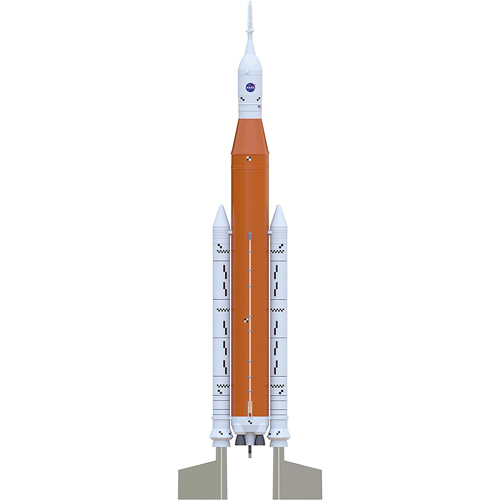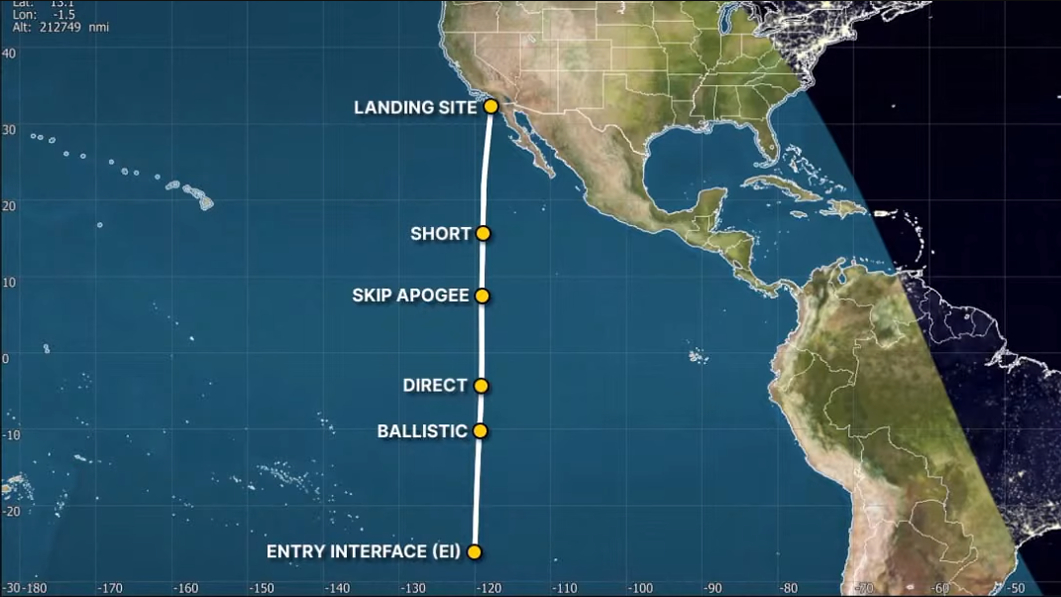What time does the Artemis 1 Orion spacecraft splash down on Dec. 11 to end NASA's moon mission?
NASA's Artemis 1 Orion spacecraft will end a 26-day mission to the moon on Sunday. Here's when it happens.
Update for Dec. 11, 12:50 pm ET: NASA's Artemis 1 Orion spacecraft successfully splashed down today, Dec. 11, and appears in good shape as recovery teams work to retrieve the spacecraft. NASA will wait about 2 hours to retrieve Orion from the ocean as part of a post-landing temperature test.
The end is in sight for NASA's historic Artemis 1 mission to the moon, which will return its Orion spacecraft to Earth on Sunday (Dec. 11) with a splashdown in the Pacific Ocean.
If you're hoping to follow along with the Orion spacecraft splashdown, you'll need to know what time it is and the events that have to go right for it to return home successfully. But don't fret, we've got you covered for all your Artemis 1 mission needs.
The Artemis 1 Orion is scheduled to splash down in the Pacific on Sunday off the western coast of Baja California at 12:40 p.m. EST (1740 GMT) to wrap a 26-day mission that began with a predawn launch on Nov. 16. You can watch the Artemis Orion splashdown live online for free via a NASA TV livestream that will begin at 11 a.m. EST (1600 GMT).
Related: How NASA's Artemis 1 Orion spacecraft will splash down in 8 steps
More: NASA's Artemis 1 moon mission: Live updates

You can launch an Artemis 1 Space Launch System of your own with this Estes NASA SLS model rocket for a 1:200 scale version of NASA's moon megarocket. Read more about it.
The uncrewed Artemis 1 Orion mission is NASA's first test flight of the rocket and spacecraft it will use to return astronauts to the moon's surface by 2025 under the agency's Artemis program. During reentry, Orion will face its most critical challenge yet: to survive the searing hot temperatures as it barrels through Earth's atmosphere and deploy its parachutes for a safe splashdown.
"We have some hard stuff ahead of us," NASA's Artemis 1 mission manager Mike Sarafin said in a press conference Thursday (Dec. 8).
Breaking space news, the latest updates on rocket launches, skywatching events and more!
Orion's descent operations begin at 12 p.m. EST (1700 GMT), when the crew capsule is scheduled to separate from its service module, which was built by the European Space Agency and contains the solar arrays, engine and propellant used to get to the the moon and back. The service module is no longer needed and will be jettisoned in a way so it poses no hazard to Orion or people on the ground, NASA has said.


At 12:20 p.m. EST (1720 GMT), Orion's crew module will begin its plunge through Earth's atmosphere, according to a NASA mission timeline. Orion will slam into Earth's atmosphere at a whopping 25,000 mph (40,000 kph), about 32 times the speed of sound. It should experience temperatures of up to 5,000 degrees Fahrenheit (2,800 degrees Celsius), which is about half as hot as the sun.
To slow the spacecraft and keep it on target, NASA will test a novel "skipping" reentry technique in which Orion will bounce of Earth's atmosphere like a skipping stone after its first atmospheric entry. The spacecraft will then make a second atmospheric entry to continue its final descent.
By 12:35 p.m. EST (1735 GMT), Orion should be at an altitude of about 40,000 feet (nearly 12,200 meters), at which time a lot of things will happen in quick succession. Within a span of four minutes, the spacecraft will deploy a series of parachutes to slow its descent even more. Under its main parachutes, Orion is expected to splash down at a speed of about 20 mph when it hits the water at 12:40 p.m. EST, NASA has said.
"When we splash down, we will actually be in the water for about two hours," Judd Frieling, NASA's Artemis 1 flight director, said Thursday. That time period will allow NASA to test the Orion's condition and its temperatures after splashdown. If everything runs on schedule, Orion should be aboard its recovery ship by 3 p.m. EST (2000 GMT).
| Event | EST | PST | GMT | Header Cell - Column 4 |
|---|---|---|---|---|
| NASA TV coverage begins | 11 a.m. | 8 a.m. | 1600 | Row 0 - Cell 4 |
| Crew module separation | 12 p.m. EST | 9 a.m. | 1700 | Row 1 - Cell 4 |
| Crew module entry interface | 12:20 p.m. | 9:20 a.m. | 1720 | Row 2 - Cell 4 |
| Altitude 40,000 feet | 12:35:28 p.m. | 9:35:28 a.m | 1735:28 | Row 3 - Cell 4 |
| Forward bay cover chute deploy | 12:36:02 p.m. | 9:36:02 a.m. | 1736:02 | Row 4 - Cell 4 |
| FBC chute jettison | 12:36:04 p.m. | 9:36:04 a.m. | 1736:04 | Row 5 - Cell 4 |
| Drogue chute deploy | 12:36:06 p.m. | 9:36:06 a.m. | 1736:06 | Row 6 - Cell 4 |
| Main parachute deploy | 12:37:26 p.m. | 9:37:26 a.m. | 1737:26 | Row 7 - Cell 4 |
| Drogue chute jettison | 12:37:26 p.m. | 9:37:26 a.m. | 1737:26 | Row 8 - Cell 4 |
| Splashdown | 12:40 p.m. | 9:40 a.m. | 1740 | Row 9 - Cell 4 |
| Orion on recovery ship | 3 p.m. | 12 p.m. | 2000 | Row 10 - Cell 4 |
| Post splashdown conference | 3:30 p.m. | 12:30 p.m. | 2030 | Row 11 - Cell 4 |
| Artemis 1 mission highlights | 6 p.m. | 3 p.m. | 2300 | Row 12 - Cell 4 |
NASA is working with the U.S. Navy to recover the Orion spacecraft from the Pacific Ocean. The Navy's USS Portland is on site to retrieve Orion and Navy and NASA divers have been rehearsing recovery plans for weeks, said Melissa Jones, NASA's landing and recovery director.
Once Orion is back on Earth, NASA has two more Artemis 1 mission events you may want to watch to close out the mission.
At 3:30 p.m. EST (2030 GMT), NASA will hold a post-splashdown press conference to discuss Orion's return to Earth and the mission overall. That briefing will be webcast live on NASA TV and feature comments from NASA chief Bill Nelson and Artemis 1 mission managers. Then, at 6 p.m. EST (2300 GMT), NASA will webcast its final Artemis 1 mission highlights video to celebrate the mission.
And that's what time NASA's Artemis 1 Orion spacecraft will splashdown to end its trip to the moon.
NASA will study the Artemis 1 Orion to see how well its systems performed during the 26-day moon flight. If all goes well, NASA aims to launch the first crewed mission on Orion, the Artemis 2 mission, in 2024 to send astronauts on a trip around the moon. Artemis 3, the first crewed moon landing mission with Orion and a SpaceX Starship lander, is scheduled for no earlier than 2025.
Email Tariq Malik at tmalik@space.com or follow him @tariqjmalik. Follow us @Spacedotcom, Facebook and Instagram.

Tariq is the award-winning Editor-in-Chief of Space.com and joined the team in 2001. He covers human spaceflight, as well as skywatching and entertainment. He became Space.com's Editor-in-Chief in 2019. Before joining Space.com, Tariq was a staff reporter for The Los Angeles Times covering education and city beats in La Habra, Fullerton and Huntington Beach. He's a recipient of the 2022 Harry Kolcum Award for excellence in space reporting and the 2025 Space Pioneer Award from the National Space Society. He is an Eagle Scout and Space Camp alum with journalism degrees from the USC and NYU. You can find Tariq at Space.com and as the co-host to the This Week In Space podcast on the TWiT network. To see his latest project, you can follow Tariq on Twitter @tariqjmalik.
